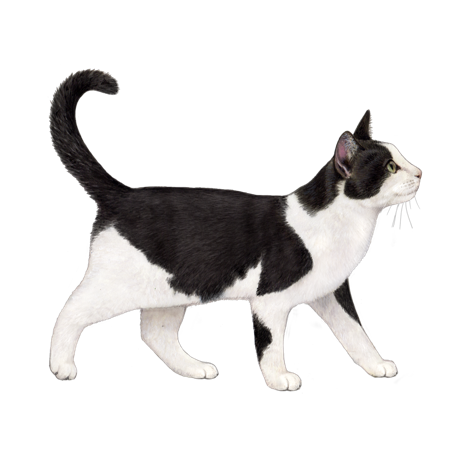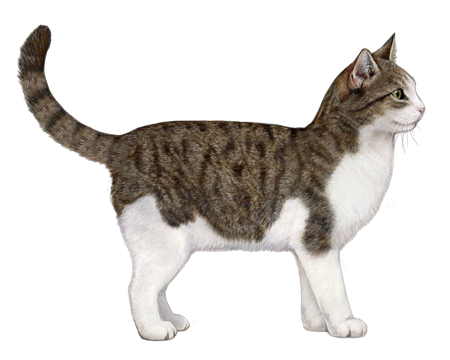
Sphynx
There's no doubt that the Sphynx's hairless appearance is a conversation starter. But as one of the world's most intelligent, social, and affectionate cat breeds, it's got more going for it than its attention-grabbing looks.
Interested in discovering if your cat is a Sphynx?
Check out Wisdom Panel's DNA test.
Sphynx Traits
General Appearance
Sphynx are medium-sized cats with a hairless appearance. They have wrinkled skin that's warm and soft in texture—similar to suede.
Coat and Colouring
Despite being known as hairless cats, Sphynx aren't completely bald. The degree of hairlessness can vary, but some cats have a fine layer of down on their bodies. They also often have light hair on their nose, ears, cheekbones, and tip of their tail.
Contrary to popular belief, Sphynx are not hypoallergenic. Like any other cat, this breed secretes a protein in their saliva and skin known to cause cat allergies.
Sphynx come in various colors and patterns, including solid, particolor, tabby, and tortoiseshell. These colors and patterns show up in the pigment of their skin or on their few visible hairs.
Distinctive Physical Traits
Sphynx have wedge-shaped heads and prominent cheekbones. Their massive ears are broad at the base and slightly rounded at the tip. Large, lemon-shaped eyes give them a sweet expression. They have broad chests, muscular bodies, and a full, round abdomen that has earned them comparisons to Buddha. Their tails are slender, long, and whip-like.
Sphynx Temperament
The Sphynx loves to be the center of attention—which is good because they turn heads wherever they go. These social kitties want to be with their humans all the time. "Independent" certainly doesn't describe the average Sphynx.
These cats get along with just about everyone, including other pets and kids. They love to curl up in a lap and even sleep on a bed under the covers. Sphynx will also happily greet visitors. Their outgoing personalities and cuddly nature make them ideal therapy cats.
But if you're looking for a quiet pet, the Sphynx is not for you. These cats are purring machines and avid conversationalists. They're also curious, alert, and active. They love to play and keep everyone in the house entertained. One of their favorite tricks is using their long toes to open doors and cupboards. And if you're up for a game of fetch or chase, chances are, they are, too!
As you might expect, Sphynx are temperature-sensitive. If the house is chilly, they'll seek out a warmer place to nap. As such, these cats are good candidates for fashionable winter sweaters.
Sphynx History
The Sphynx originated in 1966 when a black and white cat in Ontario, Canada, gave birth to a hairless kitten. When that cat (aptly named Prune) was old enough, his owner bred him with other cats to produce more hairless kittens.
Hairlessness is a recessive gene. So, some of the kittens in the resulting litters had hair, while others did not. Because they resembled the ancient Egyptian Sphinx sculptures, people began referring to them as such.
A decade later, more hairless cats appeared in Toronto and Minnesota. These kittens were crossed with another mostly hairless breed, the Devon Rex. And the offspring of these matings formed the foundation of the modern Sphynx breed.
Over the years, breeders in Europe and North America have bred the Sphynx to coated cats and back to hairless ones to strengthen their overall genetic health.
Sphynx Care
Nutrition
Sphynx have very high metabolisms and need to consume more calories than cats with coats. So, a high-quality diet is essential. To meet their nutritional needs, feed a diet appropriate for their life stage (e.g., kitten, adult, senior).
Because of their big appetites, Sphynx may try to convince you that they need an extra helping of kibble or some additional treats. To avoid overfeeding them (which can lead to obesity), measure out their meals and limit treats to no more than 10% of their daily calories.
In addition to daily meals, make sure your cat always has access to fresh, clean water.
Grooming
Despite their lack of coat, Sphynx do require bathing with a gentle shampoo to remove oily build-up on their skin. But be careful not to bathe too often, or you'll risk throwing off their natural PH balance. One bath every few months is plenty.
Pay special attention to your cat's nail beds, nose, and ears, too, as these places also collect debris. Sphynx need weekly ear cleanings to remove wax build-up and regular nail trims. Nails that get too long are more likely to snag on something and become torn or damaged. Overgrown nails can also grow into your cat's paw pads, leading to pain or infection. Besides clipping, providing a scratching post will help keep their nails in good shape and satisfy their instinct to scratch.
Like all cats, Sphynx should have a dental care routine that includes at-home teeth brushing and professional dental exams and cleanings.
Health
Some breeds are more susceptible to certain health conditions. Sphynx may be more prone to developing Hypertrophic Cardiomyopathy—which decreases the heart's efficiency and can lead to other issues. Sphynx may also be more likely to develop skin issues. Consult your veterinarian if your cat is showing signs of a rash or skin infection. And if they're outside in the sun, use sun protection to keep their skin from burning.
Sphynx Genetic Health Conditions
-
Congenital Myasthenic Syndrome (Discovered in the Devon Rex and Sphynx)
Congenital Myasthenic Syndrome (CMS) is a condition that causes muscle weakness and fatigue.
-
Cystinuria Type B (Variant 3)
Cystinuria is a condition that predisposes cats to form cystine crystals and stones within the urinary tract, which can then cause irritation and blockage.
-
Polycystic Kidney Disease (PKD)
Polycystic Kidney Disease (PKD) is the most common inherited disease in cats. The disease causes the formation of fluid-filled cysts in the kidneys that can lead to kidney failure.
With more than 45 health tests, Wisdom Panel™ Complete for Cats screens for these and other important genetic conditions—allowing you to better plan for your cat's lifelong care.
Breed Group
Western
The largest of breed groups, the Western Group is mainly comprised of cats developed in Europe and the Americas. Due to the complexity of feline genetic diversity, however, cat breeds from other regions may also be found associated with this group.


























